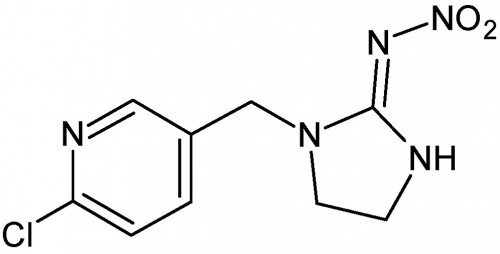Bees have been dying at a historic rate over the last decade, and the Environmental Protection Agency is now pointing a finger toward a common pesticide found throughout much of traditional agriculture.

The chemical, imidacloprid, is also a favorite insecticide among many black market marijuana growers — as well as some legal cultivation professionals who haven’t yet seen the memo that imidacloprid, like almost every other registered pesticide, is illegal for use on cannabis. In Colorado marijuana, imidacloprid is banned and considered “a threat to public safety,” according to a 2015 executive order from Governor John Hickenlooper.
Gardeners (and gardeners) might not recognize imidacloprid by that name — but the pesticide brand names Merit and Mallet will sound familiar to some. Considered “moderately hazardous” by the World Health Organization and mildly toxic if ingested or inhaled by the National Pesticide Information Center, imidacloprid is one of five neonicotinoids.
As Mother Jones’ food-and-ag writer Tom Philpott wrote:
Marketed by European chemical giants Syngenta and Bayer, neonics are the most widely used insecticides both in the United States and globally. In 2009, the agency commenced a long, slow process of reassessing them—not as a class, but rather one by one (there are five altogether). Meanwhile, tens of millions of acres of farmland are treated with neonics each year, and the health of US honeybee hives continues to be dismal.
The EPA’s long-awaited assessment focused on how one of the most prominent neonics—Bayer’s imidacloprid—affects bees. The report card was so dire that the EPA “could potentially take action” to “restrict or limit the use” of the chemical by the end of this year, an agency spokesperson wrote in an emailed statement.
Reviewing dozens of studies from independent and industry-funded researchers, the EPA’s risk-assessment team established that when bees encounter imidacloprid at levels above 25 parts per billion — a common level for neonics in farm fields — they suffer harm. “These effects include decreases in pollinators as well as less honey produced,” the EPA’s press release states.
When The Cannabist and The Denver Post tested marijuana extracts for pesticides in 2015, lab results showed 36 parts per million — or 36,000 parts per billion — of imidacloprid in a Grapefruit Diesel Wax made by Colorado cannabis company Mahatma Concentrates.
After the story ran, Mahatma issued a voluntary recall on the tainted products — and 14 other pesticide-related recalls have since been issued by the city of Denver and various cannabis companies in the four months that followed.
So far, there have been no reports of any human illness traced to chemicals used on marijuana, but worries persist — and two cannabis users have sued one of the state’s largest pot growers for allegedly using a potentially dangerous pesticide on the pot they later purchased.
